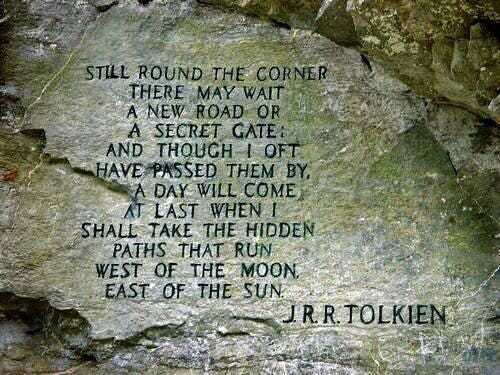The Story of the Road
In working on the rules for Shadow & Fae, I've come to a section I intended to write on how to make travel fun. There are basic rules already for travel speed, how often to roll encounters, camping, hunting, etc.
But mechanics alone cannot create fun.
How do we take a road—a line on a map—and make traveling along it exciting?
Here's what I've got so far, and I'd be interested in hearing what you have to say.
The Story of the Road
When the party sets out on their journey, consider the road and what lays along it.
What are the Denizens, Landmarks, and Detours along the way?Denizens
Random encounters don’t mean “Random” as in totally gonzo. Rather, there is a randomized chance to meet something that dwells along the road, and there is risk and reward present in each of those encounters.
Consider that there is a nearby village suffering from Wasting Disease. From that 1 fact, we can imagine several kinds of people and creatures who might be on the road.
- 3d4 Villagers looking for a new home. (2-in-6 this group is infected with wasting disease, and the party will be exposed if they interact.)
- 1 Cleric and 1d4 Acolytes, seeking to ease the suffering of the villagers.
- 2d6 Zombies (Melee Combat will expose the party to Wasting Disease)
- 1d6 Plague Doctors seeking to make a coin from the suffering folks.
- 1 Ghost desperate to leave the area. (Unburied plague victim. Proper burial to permanently put it to rest.)
- 2d6 Witch-hunters searching for whoever is responsible for the disease. (Reaction Roll to determine whether they ask the party for help or accuse them of harm.)
Note that there’s no set number of encounters required to make a road interesting. That said, sometimes fewer is better. If you do have an interesting idea later on, you can simply add it.
Once a party has encountered or dealt with something along the road, you can strike it from the list, change it, or replace it.Landmarks
What kinds of territory are along the way? If you are traveling through a forest, what makes it different from other forests?
One way of tracking the “Landmarks” of a road is to use a hex map or even a simple “Point-to-point” map. Key hexes or points with evocative and unique descriptions like:
- Massive canopy trees tower overhead, blocking out the sun. Despite the darkness, flecks of strange light dance through the canopy. Lightning Bugs.
- Endless dunes roll away in every direction, but here, for no apparent reason, stands a single 20 foot tall natural stone spire. The words “Fern was here” are scratched into the stone 2d6 feet up. Shifts up and down with wind.
- Three massive stone swords stand here, their blades piercing the earth. Each is engraved with massive runes written in a forgotten dialect of giant.
Detours
While a Landmark denotes “Something here”. A detour means there’s “Something Over There”.
Like landmarks, a detour can be noted on a hex or point on the map. A detour can be thought of as a “side-quest” during which the party risks time and resources to explore something they weren’t originally planning on.
Here are a few examples.
- An odd tilted tower stands on a hill a few miles to the East. No matter how much time the party spends traveling towards it, they grow no closer unless they walk backwards along the path. It contains a hermetic wizard looking to study the innards of live trolls.
- About 80 feet up the cliff wall you can see a cave opening. A broken rope-ladder descends 10 feet from it. Harpy Nest, Small treasure hoard.
- A small volcanic island quietly smokes about a mile off the shore. Home of Drog, a Fire Giant blacksmith, and guarded by fire elementals.
---
So, in the end it's nothing shocking, but I think the proper application of these three factors will help to take travel from a hand-waived length of time or an over-mechanical slog to an adventure through interesting and dangerous lands.



Comments
Post a Comment